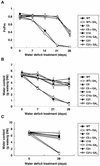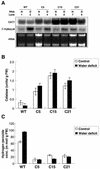Tomato plants ectopically expressing Arabidopsis CBF1 show enhanced resistance to water deficit stress
- PMID: 12376629
- PMCID: PMC166591
- DOI: 10.1104/pp.006783
Tomato plants ectopically expressing Arabidopsis CBF1 show enhanced resistance to water deficit stress
Abstract
A DNA cassette containing an Arabidopsis C repeat/dehydration-responsive element binding factor 1 (CBF1) cDNA and a nos terminator, driven by a cauliflower mosaic virus 35S promoter, was transformed into the tomato (Lycopersicon esculentum) genome. These transgenic tomato plants were more resistant to water deficit stress than the wild-type plants. The transgenic plants exhibited growth retardation by showing dwarf phenotype, and the fruit and seed numbers and fresh weight of the transgenic tomato plants were apparently less than those of the wild-type plants. Exogenous gibberellic acid treatment reversed the growth retardation and enhanced growth of transgenic tomato plants, but did not affect the level of water deficit resistance. The stomata of the transgenic CBF1 tomato plants closed more rapidly than the wild type after water deficit treatment with or without gibberellic acid pretreatment. The transgenic tomato plants contained higher levels of Pro than those of the wild-type plants under normal or water deficit conditions. Subtractive hybridization was used to isolate the responsive genes to heterologous CBF1 in transgenic tomato plants and the CAT1 (CATALASE1) was characterized. Catalase activity increased, and hydrogen peroxide concentration decreased in transgenic tomato plants compared with the wild-type plants with or without water deficit stress. These results indicated that the heterologous Arabidopsis CBF1 can confer water deficit resistance in transgenic tomato plants.
Figures






References
-
- Bajaj S, Targolli J, Liu LF, Ho THD, Wu R. Transgenic approaches to increase dehydration-stress tolerance in plants. Mol Breed. 1999;5:493–503.
-
- Baker SS, Wilhelm KS, Thomashow MF. The 5′-region of Arabidopsis thaliana COR15a has cis-acting elements that confer cold-, drought- and ABA-regulated gene expression. Plant Mol Biol. 1994;24:701–713. - PubMed
-
- Bray EA, Bailey-Serres J, Weretilnyk E. Response to abiotic stresses. In: Buchanan BB, Gruissem W, Jones RL, editors. Biochemistry and Molecular Biology of Plants. Rockville, MD: American Society of Plant Physiologists Press; 2000. pp. 1158–1203.
-
- Chan MT, Chao YC, Yu SM. Novel gene expression for plant cells based on induction of α-amylase promoter by carbohydrate starvation. J Biol Chem. 1994;269:17635–17641. - PubMed
-
- Chan MT, Yu SM. The 3′ untranslated region of a rice α-amylase gene mediated sugar-dependent abundance of mRNA. Plant J. 1998;15:685–695. - PubMed
Publication types
MeSH terms
Substances
LinkOut - more resources
Full Text Sources
Other Literature Sources
Molecular Biology Databases
Miscellaneous

